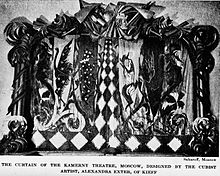Moscow Chamber Theater
The Moscow Chamber Theater ( Russian Камерный театр Таирова , Kamerny teatr Tairowa ) was a theater in Moscow .
It was founded in 1914 by Alexander Tairow , from then on managed and dissolved by the Soviet government in 1950 as part of the two-camp doctrine . In 1949 Tairow's wife Alissa Koonen had taken on the title role in Adrienne Lecouvreur after Scribe .
During the three and a half decades of its existence, the small, intimate Moscow theater gained and maintained its place as one of the driving forces in the Russian-Soviet theater landscape of that time. The most outstanding productions included The Veil of Beatrice (1915) by Schnitzler , Salome (1917) by Oscar Wilde , Princess Brambilla (1920) by ETA Hoffmann , Phèdre (1922) by Racine , Sehnsucht unter Ulmen (1926) by O'Neill , Le Jour et la Nuit (1926) by Charles Lecocq , the satirical singspiel The Beggar's Opera (1930) by John Gay and Johann Pepusch , the revolutionary play Optimistic Tragedy (1933) by Vsevolod Vishnevsky , Egyptian Nights (1934) based on Pushkin , Caesar and Cleopatra (1934) by Shaw , Antonius und Cleopatra (1934) by Shakespeare , Children of the Sun (1937) by Gorki , Madame Bovary (1940) after Flaubert , Die Möwe (1940) by Chekhov , The Guiltless Guilty (1944) by Ostrowski , a Inspector comes from Priestley (1945) and The Old Man (1946) from Gorky.
For the stage design Tairow mostly resorted to the two constructivists Alexandra Exter and Konstantin Medunetsky.
First of all, Tairow's theater survived the October Revolution and its consequences by pretending to be apolitical and drawing on the classical repertoire from both West and East in its productions. That went well until 1928. Stalin then felt mocked with Bulgakov's Blood Red Island and branded the house as a real bourgeois theater. Tairow had to reform his game plan. The Soviet government's deep-seated distrust of Tairov remained. For the Bolsheviks, Tairov was the last representative of bourgeois aestheticism on the soil of the Soviet Union.
The Moscow Realistic Theater , founded in 1927, was attached to Tairov's Theater in 1937.
In World War II , the Moscow Chamber Theater was bombed during the Battle of Moscow in the winter of 1942 and remained closed until the end of 1943. With Paustowski's play As long as the heart beats , games continued during the war.
Web links
Individual evidence
- ↑ eng. Konstantin Medunetsky
- ↑ Russian Багровый остров - Bagrowy Ostrow
- ↑ Russian Realistic Theater Moscow
- ↑ russ. Пока не остановится сердце - Poka ne ostanowitsja serdze
Coordinates: 55 ° 45 ′ 42.8 ″ N , 37 ° 36 ′ 9 ″ E
